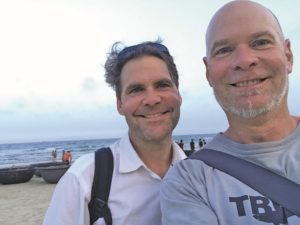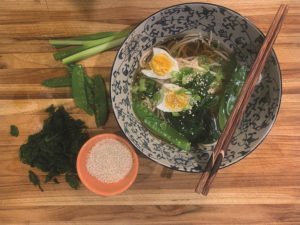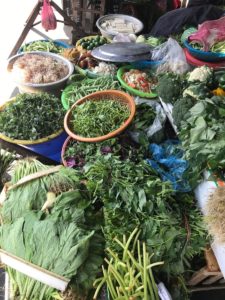I head downstairs for breakfast, round the corner of the first-floor landing, and find myself eyeball to eyeball with a water buffalo. Clearly, I’m not in Truro anymore. The buffalo is standing stock still, surrounded by emerald green, and staring intently. I stare back, unsure of the local etiquette.
It’s 2018 and I’m in Vietnam at a guest house that stands adjacent to a rice field. I’m waiting for my brother, Brit, to arrive in Danang. In the meantime, I’m visiting Hoi An, a small city south of there, at the mouth of the Thu Bon River.
Hoi An reminds me a little of Provincetown. First settled in the 7th century, Hoi An is a fishing village that has had to remake itself many times over. Like Provincetown, it has a sparkly main drag — because of lanterns that line the streets each evening rather than drag queens, but still.
Brit has been chosen by the State Dept. to be a fellow of the Young Southeast Asia Leadership Institute. The year before, he’d spent a month scootering from meeting to meeting in Myanmar. As soon as I heard he was going to Vietnam, I began my campaign for an invitation to tag along.
I wanted to see and understand Vietnam beyond childhood memories of hushed conversations and television images of helicopters and jungles. But that’s not the primary reason I wanted to go. My adult life hasn’t presented many opportunities to spend one-on-one time with my brother. I still hold tightly to the memory of a cross-country road trip we took when we were young. It involved back-country camping, fishing, dive-bar drinking, a bear encounter, and a couple of hours clinging to the side of a cliff during a freak windstorm.

And so here I am, bidding my first good morning to Vietnam. Conceding the staring contest to the buffalo, I continue down to breakfast. In the little dining room, I meet the amiable guest house owner who serves as bellman and waiter and everything else, as far as I can tell. He asks me whether my room is comfortable. It is. He wonders where I am visiting from, and, for the briefest moment, I freeze. “The United States,” I finally say, feeling surprisingly awkward. He responds enthusiastically. Yes, he knows of Boston and its universities. No, he did not realize that a large Vietnamese community thrived in Boston or that pho is a popular dish in many parts of the U.S.
He tells me how his family came to live in Hoi An after “the American War.” He says it so casually that for a heartbeat I’m puzzled: which American war? But, of course, it’s that war, and of course it’s called the American War here.
I settle in at my table overlooking the rice field, trying to sort through the excitement and anxiety I feel at being here. My host brings breakfast: a steaming bowl of fragrant broth and rice noodles, piled high with chopped herbs.
“Pho?” I ask. No, says my host, calling it by another name not previewed in my Rosetta Stone language course. The steam carries meaty aromas with flashes of citrus, onion, and anise. Poking out of the broth are fried patties, which turn out to be fish cakes. Scattered throughout the bowl are tomatoes and scallions along with the herbs. The broth is light and fresh.
The rice field, the buffalo, the American war, and the flavors of the soup swirling though my mind, I ask my host whether I might have a little more. I gather from his reaction that this is unusual. But hey, the bowl is small.
Over the next three weeks, I begin every day with a bowl of breakfast soup, usually with my brother, unless he has a morning meeting. Some, like this first bowl, are versions of bun cha ca, the fish cake and rice noodle soup that’s ubiquitous on Vietnam’s central coast. But there were many other varieties as well, each more intriguing and delicious than the last.
Back in Truro, with a cold rain coming down in dreary sheets, I pull out the tin of oatmeal and it seems just about as dreary as the day. I’m longing for something bright to warm me, and the trip to Vietnam comes to mind. A steaming, fragrant bowl of breakfast soup is what I need.
I start at the site Ang Cooks, where I’ve scored some great Vietnamese recipes. It quickly becomes clear that a batch of bun cha ca would take more time and ingredients than I have right now. Lukas Volger’s Bowl offers an easier alternative —a Japanese-style ramen with a quick dashi broth. The first time I make the soup it takes me 45 minutes, but since then I’ve created a system: I prep the broth, noodles, eggs, and veggies the night before, and come morning I can be slurping down my breakfast after only a 10-minute effort.
The recipe relies on dashi, a broth that is the starting point for many Japanese-style soups. It’s a combination of kombu (dried seaweed) and katsuobushi (dried smoked bonito flakes), both of which can usually be found at Stop & Shop and always from various online sites. Stock up; they keep forever in the cupboard.
In addition to the broth, the noodles, and the jammy egg, any kind of leftover blanched vegetable works in the dish — this recipe calls for spinach, but think green beans, snow peas, broccoli, or carrots. A cooked shrimp or two or a few cubes of firm tofu wouldn’t be out of place here, either. The dish can be made vegan by omitting the bonito flakes and egg.
Soup for Breakfast
Serves 4
For the dashi:
2 quarts water
1 oz. dried kombu
1 oz. dried bonito flakes

The noodles and garnishes:
28 oz. precooked, vacuum-sealed udon noodles or 12 ounces dried udon noodles
1 tsp. sesame oil
8 oz. fresh spinach, washed and trimmed
4 large eggs
2 scallions, trimmed and thinly sliced
4 tsp. sesame seeds
For the broth:
2 Tbsp. sesame oil plus extra for drizzling
4 garlic cloves, peeled and grated
2-inch piece fresh ginger, peeled and grated
4 cups dashi (or vegetable stock)
¼ cup shoyu or other soy sauce
1 Tbsp. mirin or sake
2 tsp. salt
2 tsp. granulated sugar
Prepare the dashi up to a week ahead. Bring 2 quarts of water and the kombu to a low simmer in a medium saucepan. Remove from heat, add the bonito flakes, cover, and allow to sit for about 5 minutes. Strain out the solids (which can be used again for a second batch of milder dashi).
Prepare the noodles and garnishes. Bring a pot of salted water to a boil. Add the noodles and cook until just tender. Drain and rinse the noodles in cold water to stop the cooking, then rinse again. Toss the noodles with a teaspoon of sesame oil to prevent them from sticking. The noodles may be prepared up to two days ahead and stored covered in the refrigerator.

Rinse the pot and bring an inch of fresh water to a boil, then add the spinach. Cook for about 60 seconds, until the leaves are wilted but still bright green. Drain and rinse the spinach in cold water to stop the cooking. Squeeze out as much liquid as possible, then squeeze the spinach into a ball and slice. The spinach (or other vegetables) may be prepared up to two days ahead and refrigerated.
Next, add a few inches of water to a small pot and bring it a boil. Carefully add the eggs, then reduce the heat to keep the water at a gentle simmer for 8 minutes for a just-set yolk. Remove the eggs and plunge them into cold water. These may be prepared up to 2 days ahead and refrigerated.
At breakfast time, make the broth by sautéing the grated garlic and ginger in 2 tablespoons of sesame oil for about 30 seconds. Add the remaining broth ingredients and an additional 2 cups of water. Let the broth come to a boil, then lower the heat and simmer it gently for about 10 minutes.
Assemble the soup by dividing the noodles among 4 large bowls. Peel and slice the eggs in half lengthwise and place on top of the noodles. Add the spinach or other vegetables. Ladle the hot broth over the noodles and garnish with a drizzle of sesame oil, sesame seeds, and scallions.
